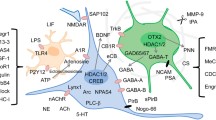Abstract
On the basis of their own data the authors postulate that the increase in sensory input during early ontogeny results in a delay in the development of the sensory systems formed earlier. In connection with this, the sensory basis of behavioral patterns becomes ineffective, causing their reorganization and the appearance of new forms of behavior. Limitation of sensory input during the critical periods of development stimulates the accelerated manifestation of behavioral patterns. However, this acceleration also has long-lasting negative effects— alterations in the processes of learning and memory in adult animals.
Similar content being viewed by others
References
L. I. Alexandrov, “Delay in the development of auditory sensitivity and reorganization of feeding behavior,” Zh. Vyssh. Nervn. Deyat.,45, No. 5, 1047 (1995).
L. I. Alexandrov and L. P. Dmitrieva, “Development of auditory sensitivity of altricial birds: absolute thresholds of evoked potentials,” Zh. Vyssh. Nervn. Deyat.,41, No. 2, 384 (1991).
L. I. Alexandrov, S. N. Khayutin, and E. V. Korneeva, “Influence of species song on auditory development of pied flycatcher nestlings,” Ornitologiya,26, 200 (1994).
K. V. Anokhin and K. V. Sudakov, “Systemic organization of behavior: novelty as a leading factor of expression of early genes in a learning brain,” Usp. Fiziol. Nauk,24, No. 3, 53 (1993).
E. M. Bogomolova and Yu. A. Kurochkin, “Systemogenesis of a behavioral act,” in: Functional Systems of an Organism [in Russian], Meditsina, Moscow (1987), p. 353.
A. D. Vorobyova and I. S. Stashkevitch, “Formation of instrumental food-acquisition behavior in adult rats using the front limb, partially denervated in early postnatal ontogeny,” Zh. Vyssh. Nervn. Deyat.,45, No. 6, 1204 (1995).
T. B. Golubeva, “The range of auditory sensitivity and the number of stereocilia on auditory epithelium hair cells in developing bird cochlea,” Dokl. Akad. Nauk SSSR,332, No. 2, 261 (1993).
T. B. Golubeva, “The delay in auditory development and the change in the leading afferentation in early ontogeny of birds,” Zh. Vyssh. Nervn. Deyat.,44, No. 6, 992 (1994).
T. B. Golubeva and L. I. Barsova, “The delay in the development of auditory brainstem nuclei during the change in the leading afferentation and behavioral patterns in early ontogeny,” 2nd Kolosov Neurohistological Conference, St. Petersburg (1994), p. 16.
T. B. Golubeva, “Acoustically guided behavior in early ontogeny of long-eared owl: characteristics of feeding behavior and parameters of acoustic signals eliciting it,” Zh. Vyssh. Nervn. Deyat.,46, No. 1, 55 (1996).
V. G. Kassil, “Motivation as a factor of ontogenetic development of behavior,” in: Physiology of Behavior. Neurobiological Trends [in Russian], Leningrad, Nauka (1987), p. 130.
E. V. Korneeva, N. G. Gladkovitch, A. D. Vorobyova, and K. V. Shuleikina, “Neuroontogeny of hyperstriatum during the change in forms of the visually guided behavior of nestlings. A morphometric study,” Zh. Evol. Biochim. Physiol.,29, No. 4, 387 (1993).
E. V. Korneeva, N. G. Gladkovitch, A. D. Vorobyova, and K. V. Shuleikina, “Dynamics of the change in forms of visually guided behavior of pied flycatcher nestlings and neuroontogeny of Wulst,” Ornitologiya,26, 215 (1994).
E. V. Korneeva, “Orientation of dendrites in Wulst neurons during the change in forms of visually guided behavior of pied flycatcher nestlings,” Zh. Evol. Biochim. Physiol.,31, No. 5–6, 642 (1995).
V. S. Luschekin, “Sensory factors of spatial orientation in kittens,” Dissertation for Candidate of Biol. Sciences, Inst. Vysshey Nervnoy Deyatelnosti i Neirofiziologii Akad. Nauk SSSR, Moscow (1983).
M. L. Pigareva and A. D. Vorobyova, “Accelerated appearance of behavioral responses in sensory-deprived rats,” Zh. Vyssh. Nervn. Deyat.,44, No. 2, 396 (1994).
S. N. Khayutin and L. P. Dmitrieva, Organization of Natural Behavior in Nestlings [in Russian], Nauka, Moscow (1981).
S. N. Khayutin and L. P. Dmitrieva, Organization of Early Species-Specific Behavior [in Russian], Nauka, Moscow (1991).
V. B. Shvyrkov, Neurophysiological Study of Systemic Mechanisms of Behavior [in Russian], Nauka, Moscow (1978).
K. V. Shuleikina, Systemic Organization of Feeding Behavior [in Russian], Nauka, Moscow (1971).
K. V. Shuleikina and V. S. Luschekin, “Relations between the types of sensory orientation in kittens' behavior,” New Studies in Developmental Physiology, No. 2/19, 13 (1982).
L. I. Alexandrov and E. V. Korneeva, “Species-specific acoustic signals affect the auditory development in altricial nestlings,” J. Ornithol.,135, 155 (1994).
T. Fillion and E. M. Blass, “Infantile experience with suckling odors determines adult sexual behavior in the male rats,” Science,231, No. 4379, 729 (1986).
G. Gottlieb, “Prenatal behavior of birds,” Quart. Rev. Biol.,43, No. 3, 148 (1968).
G. Gottlieb, Development of Species Identification in Birds, Chicago Univ. Press, Chicago (1971).
G. Gottlieb, “Role of early experience in species-specific perceptual development,” in: Development of Perception, Vol. 1, R. N. Aslin et al. (eds.), Academic Press, New York (1981), p. 5.
K. Lorenz, Evolution and Modification of Behavior, Univ. Chicago Press, Chicago (1963).
L. Schermuli and R. Klinke, “Change of characteristic frequency of pigeon primary auditory afferents with temperature,” J. Comp. Physiol.,156, 209 (1985).
W. H. Thorpe, Learning and Instinct in Animals, Methuen, London (1963).
N. Tinbergen, The Study of Instinct, Oxford University Press, Oxford (1951).
Additional information
Institute of Higher Nervous Activity and Neurophysiology, Russian Academy of Sciences, Moscow. Translated from Zhurnal Vysshei Nervnoi Deyatel'nosti imeni I. P. Pavlova, Vol. 47, No. 2, pp. 299–307, March–April, 1997.
Rights and permissions
About this article
Cite this article
Raevsky, V.V., Alexandrov, L.I., Vorobyeva, A.D. et al. Sensory information—The major factor of ontogeny. Neurosci Behav Physiol 27, 455–461 (1997). https://doi.org/10.1007/BF02462947
Issue Date:
DOI: https://doi.org/10.1007/BF02462947




